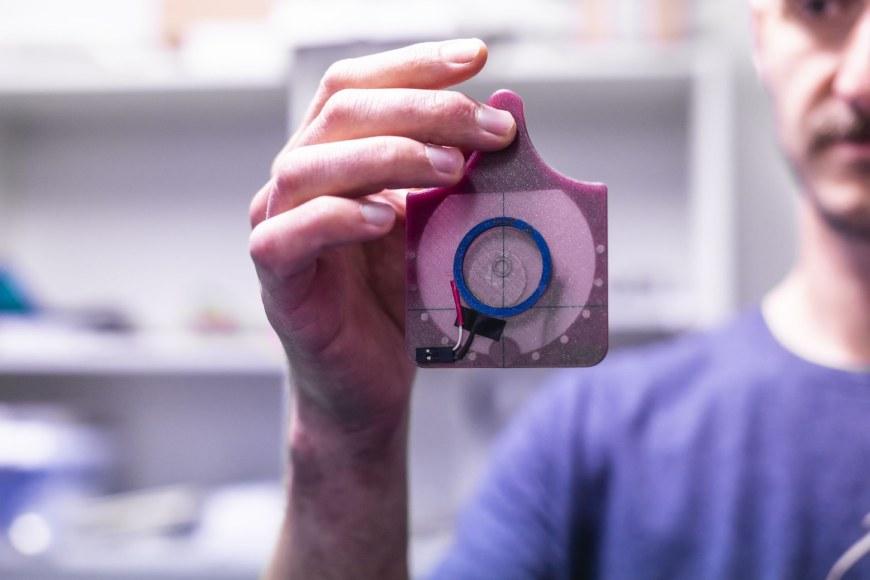No more batteries! Harvesting electrical energy from the movement of animals

This article was originally published in Unit, the magazine of Tampere Universities.
A few years ago, David Blažević, a Marie Curie Research Fellow at Tampere University, took a total break from his academic career to work full-time on a goat farm.
“I was looking for a change, so I ended up working as a goat herder and all-round farmhand,” Blažević says.
“I wrote my doctoral dissertation on the kinetic energy harvesting of machine vibrations, and while working with goats I started to wonder whether the movement of the animals could be converted to electricity,” he explains.
Finding a new research topic led Blažević to Tampere University, Finland, where he has now worked for two years in the Research Group of Electromechanics with Professor Paavo Rasilo and Postdoctoral Fellow Janne Ruuskanen. He has received the three-year Marie Curie grant for his project.
Blažević studies technologies for harvesting energy from the movement of animals in the context of precision livestock farming (PLF). Energy harvesting enables the generation of electricity, for example, from mechanical vibration or friction.
He is currently developing a device for harvesting kinetic energy from animals’ movements and converting it into electricity.
Electricity can be generated from the movement of animals to supply power, for example, to collar-mounted devices that track grazing livestock. These smart technologies can also monitor the health and welfare of animals. For example, if the device detects a rise in an animal’s body temperature, indicating a potential illness, the animal can be separated from the rest of the herd to prevent an outbreak.
“Similar devices are already available on the market, but the downside is that they all run on batteries. My goal is to find a way to replace batteries and power the devices with the kinetic energy produced by the animals,” Blažević says.
Generate electricity whenever and wherever
Currently, Blažević’s research involves much field work. He has developed several prototypes and tested one on cows to create a lightweight, robust, and unobtrusive wearable device for harvesting kinetic energy.
“We attached a device designed by our master’s student to a cow’s leg, and it generated electricity when the cow moved, just as we wanted. In the second experiment, we connected the device to a computer through Bluetooth to track the cow’s proximity, using the electricity generated by its movement,” Blažević says.
“The next step is to build and test more prototypes, which must also go through a rigorous peer review. I am very excited about our findings because nothing like this has ever been reported,” he notes.

Energy harvesting from the movement of animals is an important topic because it holds the potential to make batteries obsolete in PLF technologies for tracking animals and monitoring their health and welfare.
“The production of batteries – and the mining of the minerals used in batteries – have a negative impact on the environment and biodiversity. Besides, current recycling solutions are not able to recover all the valuable materials from batteries,” Blažević says.
“Kinetic energy harvesting would eliminate this resource-intensive process altogether by generating electricity from an internal source whenever and wherever it is needed,” Blažević points out.
An innovation with countless potential applications
According to Blažević, there has been very little previous research reported specifically on the harvesting of energy from the movement of animals. Although the topic has been more widely studied on a general level, a major breakthrough is yet to be achieved.
“Studies have been conducted on human subjects, but so far the devices for converting kinetic energy into electrical energy have not generated enough energy or have not been usable or durable enough. The challenge lies in creating a device that is not only powerful but also small and affordable,” he says.
Kinetic energy harvesting has a broad range of potential applications, Blažević finds. Not only is there vast potential for generating energy from the movement of animals, scaling up the technology to people would open a whole new world of possibilities.
“Harvesting kinetic energy has virtually unlimited potential applications because it makes the devices autonomous energy-wise. I am particularly interested in applying this technology to the pasture fencing of livestock,” he says.
Virtual fencing is an animal-friendly system for corralling free-ranging livestock in a designated area of pasture without fixed fences. The animals are fitted with a collar-mounted device that sends them a signal – such as an audio cue or a mild electric shock – when they are approaching the virtual boundary. This teaches the animals to stay within the prescribed area.
According to Blažević, virtual fences would be beneficial for the well-being and regeneration of pastures as it can prevent overgrazing by facilitating moving livestock between fields.
The driving force behind Blažević’s research is his commitment to improve the well-being of animals and to protect nature.
“Through my research, I want to make a mark in the world and inspire people,” David Blažević says.
Author: Nelli Peltonen







